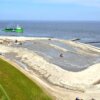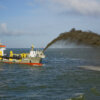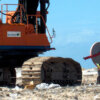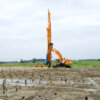Rainbowing is a method by which trailing suction hopper dredgers place material in shallow areas by pumping into the air through a hose with a nozzle.
During rainbowing, a trailing suction hopper dredger pumps the sand that has been claimed from the seabed and transported in its hopper in a high arc placing it at the reclamation site.
Rainbowing by trailing suction hopper dredgers
Rainbowing is employed when water depths are limited and a trailing suction hopper dredger can get in rather close to the designated site. The technique is often used for beach replenishment where a beach is being shored up to prevent erosion for coastal protection or recreation (or both) to a reclamation site where new land or islands are being built for port expansion, recreation or multiple other purposes. It is used to start the process of building an island in open water and once the island is in place, filling can be continued using pipelines.
The distances that the rainbowing method can reach depends on:
- the strength of the dredger’s pumps,
- the flow rate, and
- the concentration of the sand and water mixture.
The strength of the pumps on a dredger vary with the size of the trailing suction hopper dredger, but the largest trailers have large hoppers, can travel long distances, and have heavy pumps for rainbowing.
The process starts when the trailer’s dragheads, which suction up the sediment, mixes it with water to form a solid water slurry. This slurry mixture, because of its liquid qualities, can be forced as a projectile through the air in an arc onto the beach or the reclamation area.
Cost-efficient
Rainbowing is often the best method for discharging huge quantities of sand in shallow locations close to shore, for land reclamation projects or beach replenishment. Since rainbowing does not require floating or submerged pipelines, boosters or landlines, it is often the most economical, cost-efficient method.



















